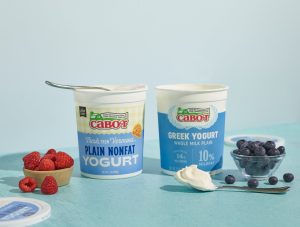Food Drink
The Creamy Conundrum: Yogurt’s Fat Content, Satiety, and Your Dietary Choices

This article delves into the fat content of Greek yogurt and regular yogurt, unraveling how it can impact feelings of fullness and satiety, and provides insights into choosing the right option for your dietary preferences.
Greek Yogurt vs. Regular Yogurt: The Fat Factor
Fat Content:
-
- Greek Yogurt: Greek yogurt tends to be lower in fat, especially when you opt for fat-free or low-fat varieties. A 6-ounce serving may contain as little as 0-5 grams of fat.
- Regular Yogurt: Regular yogurt can have varying fat content, with a 6-ounce serving containing approximately 2-7 grams of fat, depending on whether it’s whole, reduced-fat, or low-fat.
Image by: https://cabotcreamery.com/blogs/health-education/greek-yogurt-vs-regular-yogurt
Satiety and Fullness:
-
- Greek Yogurt: The higher protein and lower fat content in Greek yogurt contribute to a feeling of fullness and satisfaction, making it a satiating option. It helps curb hunger and keeps you feeling satisfied for longer periods.
- Regular Yogurt: Regular yogurt’s fat content can add creaminess and mouthfeel to the product, which some individuals find more satisfying. However, it may not offer the same satiety benefits as Greek yogurt due to its lower protein content.
Balancing Fat Intake:
-
- Dietary Preferences: The choice between Greek and regular yogurt depends on your dietary preferences and goals. If you prefer a creamier texture and don’t mind the slightly higher fat content, regular yogurt might be your choice. If you’re looking to reduce fat intake and increase protein for weight management, Greek yogurt could be a better fit.
Incorporating Yogurt into Your Diet:
- Snacking: Yogurt is a versatile and convenient snack. You can top it with fruits, nuts, or a drizzle of honey for added flavor and nutrition.
- Smoothies: Both Greek and regular yogurt can be used to create creamy and satisfying smoothies. Add your favorite fruits and vegetables for a nutritious blend.
- Baking: Yogurt can be used in baking as a healthier substitute for ingredients like sour cream or heavy cream.
https://i.pinimg.com/originals/d4/fa/70/d4fa70db6057d6f12565c853813839e7.jpg
Conclusion: Finding Your Creamy Comfort
The fat content in yogurt plays a role in texture and overall satisfaction. Whether you lean toward the creaminess of regular yogurt or prefer the satiating power of Greek yogurt, both options offer unique benefits. Your choice depends on your dietary goals and personal taste preferences, ensuring that you find your creamy comfort while nourishing your body.
Food Drink
Top 10 Trends in North America and Europe Table Eggs Industry

Introduction
The North America and Europe table eggs market size is predicted to reach US$ 51.2 Bn by 2032, up from US$ 32.5 Bn in 2025. According to Persistence Market Research, this growth will likely occur at a compound annual growth rate of approximately 6.7 percent throughout the forecast period between 2025 and 2032.
Growing Demand for Specialty and Ethical Egg Choices
Consumers are increasingly prioritizing how their food is produced, and eggs are no exception. Demand for specialty varieties such as free-range, pasture-raised, and organic eggs continues to climb across North America and Europe. These egg types come from hens raised under higher welfare standards and more natural conditions.
Drivers of this trend include rising awareness of animal welfare, perceived nutritional advantages of specialty eggs, and a willingness to pay more for quality and traceability. As labeling standards and third-party certifications become more accessible and visible, shoppers feel more confident purchasing premium egg products. The trend is expected to continue outpacing conventional egg sales.
Rising Popularity of Value-Added Egg Products
While traditional shell eggs remain a kitchen staple, the market for value-added and convenience-focused egg products is growing rapidly. Innovations include:
- Liquid eggs and egg whites in resealable cartons
- Pre-cooked, peeled hard-boiled eggs
- Egg-based meal kits and baking mixes
- Shelf-stable, vacuum-sealed egg options
Busy lifestyles and growing interest in meal prepping and high-protein diets are major factors behind this demand. Foodservice providers also favor bulk and ready-to-use egg formats that ensure consistency and safety. As a result, manufacturers are doubling down on packaging innovation, portion-controlled formats, and multifunctional uses.
Automation and Technological Integration in Production
Egg producers are investing heavily in automation to enhance efficiency, biosecurity, and overall productivity. Advanced systems such as robotic egg collection, automated sorting and grading, and precision feeding are becoming standard.
These technologies help reduce labor dependency, improve hygiene, and produce consistent, high-quality outputs. Smart barn controls for ventilation and lighting are also helping producers maintain optimal living conditions for hens, aligning with both welfare and production goals.
Stronger Focus on Biosecurity and Disease Prevention
Events like avian influenza outbreaks have compelled producers to reinforce biosecurity protocols. Modernization efforts now include:
- Closed housing systems
- Disinfecting access points
- All-in, all-out flock management systems
- Enhanced egg sanitization
- Regular disease surveillance and testing
Such measures not only prevent devastating disease outbreaks but also build trust with consumers who are increasingly mindful of food safety.
Sustainability and Circular Economy Practices
Environmental responsibility is playing a larger role in shaping both policy and consumer choices. Egg producers are adapting by implementing practices that reduce waste and energy consumption. These include:
- Using manure as biofertilizer or energy source
- Recycling water in production systems
- Installing energy-efficient LED lighting and climate controls
- Using biodegradable or recyclable packaging materials
Local sourcing of feed is another key strategy helping reduce the carbon footprint and supporting regional agriculture.
Rise in Fortified and Functional Egg Products
Health-conscious consumers are driving growth in fortified egg options, such as:
- Omega-3 enriched eggs
- Vitamin D fortified eggs
- Lutein and antioxidant-enhanced eggs
These products are marketed for their targeted benefits like heart support, bone strength, and eye health. Branding, nutritional labeling, and in-store promotions are helping these niche products gain traction among fitness-oriented and older demographic groups.
Expansion of Digital and Direct-to-Consumer Channels
Digital transformation is taking hold in egg distribution and traceability. Farms and retailers alike are investing in e-commerce platforms, online marketplaces, and subscription delivery services. Additional tools include:
- QR codes for tracking hen diet, farm origin, and welfare practices
- Real-time dashboards for producers to monitor flock health and feed usage
- Predictive analytics to optimize production and supply
Transparency and convenience are key benefits of this shift, building stronger trust between consumers and producers.
Tighter Regulatory Oversight and Higher Standards
Governments across the U.S. and European Union are steadily raising the bar on food safety and animal welfare. Policies include:
- Phasing out of cage-only housing systems
- Enhanced labeling requirements around hen housing and feed
- Stricter limits on microbial contamination
- Regulation of antibiotic use and required withdrawal periods
Compliance with these regulations not only adds operational costs but also opens access to premium markets and builds consumer confidence.
Competing Pressures from Alternative Proteins
Plant-based and lab-grown egg alternatives are gaining market share, especially in health and environmentally focused markets. However, traditional egg producers are responding with diversified offerings such as liquid egg products, protein-rich egg whites, and functional food ingredients derived from eggs. Eggs remain competitive due to their affordability, natural composition, and culinary versatility.
Consolidation and Strategic Partnerships
The egg industry is undergoing consolidation as large players acquire regional producers and specialty farms. Retailers are launching private-label egg lines, while producers form partnerships with foodservice and health supplement brands. These moves improve efficiency, expand market reach, and facilitate investment in research and innovation.
Regional Market Dynamics
1. North America
In the U.S., consumer interest in cage-free and organic eggs is growing rapidly, aided by large retailers making cage-free pledges. Canada is enhancing its traceability and adopting higher welfare standards. In Mexico, the rising middle class is fueling demand for nutrition-forward egg products.
2. Europe
Western Europe is seeing a major shift toward ethical egg production, especially in Germany, France, and the UK. Nordic and Benelux countries prioritize sustainability and specialty offerings. Eastern Europe is modernizing its production facilities while developing its role in exports.
Digital Traceability and QR Codes
Building on transparency, digital traceability uses QR codes, RFID tags, and smartphone apps. Scanning a code reveals hatch date, farm location, and batch tests. Some platforms gamify the experience, offering loyalty points or recipes when buyers scan eggs. This high-tech approach appeals to Millennials and Gen Z, who seek interactive and trustworthy shopping experiences.
Price Volatility and Market Consolidation
Feed costs, energy prices, and disease risks make egg prices volatile. The North America egg market saw sharp swings during avian influenza outbreaks, while Europe faced feed supply issues. In response, larger integrators acquire regional farms, seeking economies of scale and supply stability. Smaller producers often form cooperatives or contract with big buyers to share risks. This consolidation shapes the competitive landscape.
E-Commerce and Direct-to-Consumer Sales
Online grocery shopping and farm-to-door deliveries are booming. Producers set up subscription boxes for weekly egg deliveries, often paired with other farm goods. Retailers partner with meal kit services and offer click-and-collect options. Virtual storefronts allow farms to share stories and host live farm tours, connecting consumers directly with producers. This trend strengthens brand loyalty and captures higher margins by bypassing traditional middlemen.
Conclusion
The table eggs industry trends in North America and Europe reflect a shared drive for better animal welfare, greener practices, and stronger connections between farm and consumer. From the rise of cage-free and organic systems to the growth of plant-based alternatives and digital traceability, producers must adapt to shifting demands. Sustainable packaging and value-added products further boost market appeal, while price swings and consolidation challenge operators to innovate and collaborate. As e-commerce channels expand, farms can engage shoppers directly, offering fresh, trustworthy eggs with a clear story. Staying informed on these trends will help stakeholders thrive in 2025 and beyond.
Food Drink
Finding the Best Canola Oil Suppliers in Canada: What You Need to Know

Introduction
Finding the right canola oil suppliers in Canada can save you time and money. Canada is the world’s top producer of canola, so choices abound. But not all suppliers offer the same quality, price, or service. In this guide, we break down what you need to know before you buy. You will learn how to compare suppliers, check certifications, evaluate shipping, and support eco-friendly practices. Whether you buy small or bulk, these tips will help you make a smart choice—and keep your kitchen or business running smoothly.
When it comes to high-quality, heart-healthy cooking oils, canola oil remains a top choice for households and businesses alike. Extracted from the seeds of the canola plant, this light and neutral-flavoured oil is rich in Omega-3 and low in saturated fats, making it a favourite across kitchens in Canada and beyond. But with growing demand, how do you choose the right canola oil suppliers in Canada?
Why Quality Matters
Canola oil is a kitchen staple and an industrial ingredient. Poor quality oil can taste off and break down under heat. High-grade oil has a clean flavor and a high smoke point. Look for suppliers who source from healthy fields and use gentle pressing methods. Cold-pressed or expeller-pressed oil often retains more nutrients. Always ask for a sample or detailed lab report. Good quality protects your recipes, your customers, and your reputation.
Top Growing Regions in Canada
Most canola in Canada comes from Alberta, Saskatchewan, and Manitoba. These provinces have ideal soil and climate. Suppliers in these regions often have deep expertise. Some farms are family-run, while others operate large-scale co-ops. Regional differences affect flavor and price. For example, prairie-grown canola may have a slightly nuttier taste. When you know a supplier’s location, you can match oil character to your needs.
How to Evaluate Suppliers
A reliable supplier should be transparent. Check their website for production details. Do they list farm partners or processing methods? Ask if they offer traceability—so you know exactly where your oil comes from. Read customer reviews on industry forums. Contact other buyers to learn about their experience. Good communication—fast responses, clear paperwork, and easy ordering—often signals a trustworthy partner.
Pricing and Packaging Options
Canola oil prices fluctuate with crop yields and market demand. Compare quotes from several suppliers before you buy. Watch for hidden fees like shipping, taxes, or packaging surcharges. Many suppliers offer tiered pricing: smaller orders cost more per liter, while bulk orders reduce per-unit costs. Packaging can range from retail bottles to large drums or flexitanks. Choose the size that fits your storage and usage needs.
Certifications to Look For
Certifications show a supplier meets strict standards. Look for:
-
Non-GMO Project Verified: Confirms no genetically modified ingredients.
-
Organic Certification: Ensures no synthetic pesticides or fertilizers.
-
ISO or HACCP: Indicates strong quality-management systems.
-
Kosher or Halal Certifications: Required for specific markets.
Certified suppliers often undergo regular audits. This extra step helps ensure consistent quality and safety.
Logistics and Shipping
Canada’s vast size means shipping can be complex. Suppliers near major highways, rail lines, or ports can ship more quickly and cheaply. Ask about lead times and tracking options. If you order bulk, check whether the supplier handles customs clearance and local delivery. Some will coordinate everything, while others leave it to you. Clear logistics planning avoids delays and extra costs.
Why Choose Canola Oil?
Canola oil isn’t just another edible oil — it’s a Canadian success story. Developed right here in Canada, canola oil has earned global acclaim for its:
-
Health benefits: Low in trans fat and cholesterol
-
Versatility: Ideal for frying, baking, sautéing and even salad dressings
-
Neutral taste: Allows the natural flavour of your ingredients to shine
-
Long shelf life: Great for commercial kitchens and bulk buyers
What Makes a Reliable Canola Oil Supplier?
Whether you’re a wholesaler, food manufacturer, or retailer, choosing a reliable canola oil supplier in Canada is crucial for quality, consistency, and affordability. Here are key factors to consider:
-
Certifications and Compliance: Ensure your supplier meets CFIA standards and holds certifications like FSSC 22000 or ISO for food safety.
-
Cold-Pressed or Refined Options: Depending on your needs, ask whether the supplier offers non-GMO, cold-pressed, or expeller-pressed options.
-
Bulk Supply Capability: Do they offer wholesale quantities with stable delivery timelines?
-
Transparent Sourcing: Top suppliers will provide traceability right from farm to bottle.
-
Private Labelling Services: If you’re building your own brand, private labelling can be a game-changer.
Top Regions for Canola Oil Production in Canada
Canada is the world’s largest exporter of canola oil. Key producing provinces include:
-
Saskatchewan
-
Manitoba
-
Alberta
These regions boast some of the most fertile farmlands and contribute to the superior quality of Canadian canola oil.
Vikmar Foods: A Trusted Canola Oil Supplier
If you’re looking for a dependable name among canola oil suppliers in Canada, look no further than Vikmar Foods. Known for their premium-grade edible oils and strong global export network, Vikmar Foods offers:
-
Bulk canola oil supply for retail, HORECA, and industrial use
-
Custom packaging and labelling
-
Competitive pricing with global shipping support
-
Strict quality control with certified processing units
With an excellent track record in customer satisfaction and a strong emphasis on sustainability, Vikmar Foods stands out as a go-to supplier for canola oil in both domestic and international markets.
Final Thoughts
Choosing the right canola oil supplier in Canada isn’t just about price—it’s about trust, quality, and long-term partnership. Whether you need refined canola oil for mass production or cold-pressed oil for health-conscious consumers, always work with a supplier who meets your business needs with professionalism and integrity.
Food Drink
Easy Plant-Based Recipes &Drinks for Health Fans 2025

Introduction
Eating plant-based is easier than ever in 2025. With a focus on wellness and sustainability, easy plant-based recipes and plant-based drinks help health fans feel energized and reduce their environmental impact. You don’t need fancy ingredients or long cooking times to enjoy delicious, nourishing meals. From quick vegan breakfasts to satisfying dinners and refreshing smoothies, a plant-based diet offers variety and flavor for every palate.
In this article, you’ll discover what is plant-based diet, why choose vegan recipes, and practical tips to build simple, healthy meals. We cover breakfast, lunch, dinner, snacks, and drinks with easy steps you can follow today. A handy table lists top recipes and drinks, their ingredients, and prep times. Let’s explore the best 2025 health trends for plant-based cooking!
What Is a Plant-Based Diet?

Image by: Yandex.com
A plant-based diet focuses on whole foods from plants—fruits, vegetables, gluten free grains, beans, nuts, and seeds. Unlike strict veganism that avoids all animal products, plant-based eating centers on health. You may still consume small amounts of dairy milk or eggs, but the bulk of your meals come from plants.
Benefits of a plant-based diet include:
- Rich in Nutrients: Plants provide vitamins, minerals, fiber, and antioxidants.
- Weight Management: High fiber and low-calorie foods help maintain a healthy weight.
- Heart Health: Plant foods lower cholesterol and blood pressure.
- Sustainability: Plant farming generally uses fewer resources and emits less greenhouse gas than livestock.
By adding easy plant-based recipes to your weekly menu, you tap into these health and environmental perks without major lifestyle changes.
Breakfast Ideas for a Powerful Start

Image by: Yandex.com
1. Overnight Oats with Berries
Overnight oats are a staple quick vegan meal. Mix rolled oats with plant milk and chia seeds in a jar. Refrigerate overnight. In the morning, stir in fresh berries, a drizzle of maple syrup, and a sprinkle of nuts. Ready in under five minutes!
2. Green Smoothie Bowl
Blend spinach, frozen banana, plant-based yogurt, and a splash of almond milk. Pour into a bowl and top with granola, sliced kiwi, and chia seeds. This smoothie provides protein and healthy fats to fuel your day.
3. Avocado Toast with Tomato and Hemp Seeds
Toast whole-grain bread, mash ripe avocado, and spread evenly. Top with sliced tomato, hemp seeds, and a pinch of salt and pepper. Hemp seeds add a boost of protein and omega-3s.

Image by: Yandex.com
1. Chickpea Salad Wrap
Mash canned chickpeas with vegan mayo, lemon juice, chopped celery, and green onions. Spread the mixture on a whole-wheat tortilla, add lettuce, and roll up. This healthy vegan recipe is high in protein and fiber.
2. Buddha Bowl with Tahini Dressing
Fill a bowl with cooked quinoa, roasted sweet potatoes, steamed broccoli, and sliced cucumber. Drizzle with tahini mixed with lemon juice, garlic, and water. Buddha bowls let you mix and match veggies, grains, and dressings.
3. Lentil Soup
Simmer lentils with diced carrots, celery, onion, garlic, and vegetable broth. Season with cumin, paprika, and salt. This soup warms you up and keeps you full for hours. Cook a big batch to enjoy leftovers.
Dinner Recipes for Comfort and Health

Image by: Yandex.com
1. Vegan Stir-Fry with Tofu
Sauté cubed tofu in sesame oil until golden. Remove and stir-fry broccoli, bell peppers, snap peas, and carrots. Add garlic and ginger, then return tofu. Pour in soy sauce, rice vinegar, and a touch of maple syrup. Serve over brown rice. Stir-fries are quick, customizable, and colorful.
2. Eggplant and Chickpea Curry
Cook diced eggplant in olive oil until soft. Add onion, garlic, and curry powder. Stir in canned chickpeas and coconut milk. Simmer until thick. Garnish with cilantro and serve with basmati rice. Curries transport your taste buds with warm spices.
3. Zucchini Noodles with Pesto
Use a spiralizer to make zucchini noodles. Toss with vegan basil pesto—blend basil, pine nuts, garlic, lemon juice, olive oil, and nutritional yeast. Heat briefly in a pan and serve warm. Zoodles cut carbs and increase veggie intake.
Refreshing Plant-Based Drinks

Image by: Yandex.com
1. Classic Green Smoothie
Blend spinach, apple, celery, cucumber, lemon juice, and coconut water. This plant-based drink hydrates and delivers a vitamin-rich punch.
2. Turmeric Golden Milk
Heat plant milk with turmeric, ginger, cinnamon, and a pinch of black pepper. Sweeten with maple syrup. Golden milk soothes inflammation and tastes cozy.
3. Vegan Protein Shake
Mix plant-based protein powder with almond milk, frozen berries, and a banana. Blend until smooth. Perfect post-workout for muscle recovery.
4. Iced Matcha Latte
Whisk matcha powder with a little hot water until frothy. Fill a glass with ice and plant milk, then pour matcha over. Matcha provides gentle caffeine and antioxidants.
Comparative Table: Easy Plant-Based Recipes & Drinks
| Recipe/Drink | Main Ingredients | Prep Time | Key Benefit |
|---|---|---|---|
| Overnight Oats with Berries | Oats, plant milk, chia seeds, berries | 5 mins | High fiber, easy grab-and-go |
| Green Smoothie Bowl | Spinach, banana, plant yogurt, almond milk | 10 mins | Nutrient-rich, satisfying |
| Avocado Toast | Bread, avocado, tomato, hemp seeds | 5 mins | Healthy fats, quick snack |
| Chickpea Salad Wrap | Chickpeas, vegan mayo, celery, tortilla | 15 mins | Protein-packed lunch |
| Vegan Stir-Fry | Tofu, mixed veggies, soy sauce, rice | 20 mins | Balanced meal, versatile |
| Eggplant Chickpea Curry | Eggplant, chickpeas, coconut milk, spices | 30 mins | Warm spices, filling |
| Zucchini Noodles with Pesto | Zucchini, basil, pine nuts, nutritional yeast | 15 mins | Low-carb, pesto flavor |
| Roasted Chickpeas | Chickpeas, olive oil, spices | 20 mins | Crunchy snack, protein |
| Classic Green Smoothie | Spinach, apple, cucumber, coconut water | 5 mins | Hydrating, vitamin boost |
| Turmeric Golden Milk | Plant milk, turmeric, ginger, cinnamon | 10 mins | Anti-inflammatory, soothing |
| Vegan Protein Shake | Vegan protein powder, berries, almond milk | 5 mins | Post-workout recovery |
| Iced Matcha Latte | Matcha powder, plant milk, ice | 5 mins | Gentle energy, antioxidants |
Use this table to pick recipes and drinks that fit your schedule and taste. Each option takes 30 minutes or less, so you can eat healthy even on busy days.
Conclusion
Embracing easy plant-based recipes and plant-based drinks brings health and variety to your table in 2025. From overnight oats and green smoothies to chickpea wraps and golden milk, simple ingredients create delicious, nutrient-packed meals. By planning ahead, balancing macronutrients, and trying new flavors, you can enjoy a vibrant plant-based diet that aligns with 2025 health trends. Remember to include pea protein sources, stay hydrated, and listen to your body’s needs. With these hacks and recipes, plant-based eating is both achievable and exciting for health fans everywhere.
-
Business2 years ago
Cybersecurity Consulting Company SequelNet Provides Critical IT Support Services to Medical Billing Firm, Medical Optimum
-
Business2 years ago
Team Communication Software Transforms Operations at Finance Innovate
-
Business2 years ago
Project Management Tool Transforms Long Island Business
-
Business2 years ago
How Alleviate Poverty Utilized IPPBX’s All-in-One Solution to Transform Lives in New York City
-
health2 years ago
Breast Cancer: The Imperative Role of Mammograms in Screening and Early Detection
-
Sports2 years ago
Unstoppable Collaboration: D.C.’s Citi Open and Silicon Valley Classic Unite to Propel Women’s Tennis to New Heights
-
Art /Entertainment2 years ago
Embracing Renewal: Sizdabedar Celebrations Unite Iranians in New York’s Eisenhower Park
-
Finance2 years ago
The Benefits of Starting a Side Hustle for Financial Freedom
































